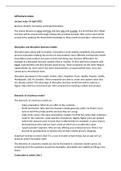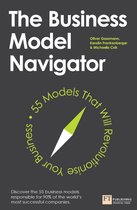All lecture notes
Lecture notes 14 April 2022
Business Models: Innovation and Experimentation
The course focuses on what and how, but also why and so what. It is all of these four. What
and how will be answered through looking into practical example. Why and so what will be
answered by applying the theoretical knowledge to these practical examples / phenomena.
Disruption and disruptive business models
Disruption goes along with innovation. Innovation can be making completely new products,
process innovation (making the process of new products more efficient) and business model
innovation (same product and same process but doing your business differently). An
example of a disruptive business models: Flink or Gorillas they started to compete with
bigger supermarkets and they became quite strong. These companies do the same thing as
supermarkets do, but it hasn’t the same characteristics as supermarkets have, since you
cannot go to the physical store.
Disruptive businesses in the media: Airbnb, Uber, Swapfiets, Picnic, Spotify, Ryanair, Netflix,
Marktplaats, Lidl, Mc Donalds. These companies are able to create and capture value that
are already existed. The advantage of disruptive business model innovation captures a
higher value with less investment per ratio compared to inventing a whole new product.
Elements of a business model
The elements of a business model are:
- Value proposition. What do you offer to the customer.
- Profit mechanism. Why does the business model generate profit. For Flink it is too
early to tell if they make profits, because they are young.
- Value chain. How is the value proposition created. For Flink the value chain is delivery
costs for the customer, small selection of products, slightly higher price per product
(where the resource price is lower than in Albert Heijn for example). A value chain is
the business process and you have a look at where you can add extra value.
- Target customer segment. Who are you offering your product/service. Flink is not
focused on grandparents or families who do their weekly grocery shopping.
Important to keep in mind is that IT is a way to enable certain things, but an app isn’t an
business model innovation itself.
The elements of a business model can also be illustrated in a business model canvas, by
answering all of the questions around the feasibility, desirability and viability by filling in the
boxes.
Connection to article Zott C
,The business model is emerging as a new unit of analysis; business models emphasize a
system-level (understanding of the whole system), holistic approach to explaining how firms
do business; firm activities play an important role in the various conceptualizations of
business models that have been proposed; and business models seek to explain how value is
created, not just how it is captured.
Processes do play a role in a business model, but a business model is more than only
processes.
Business model has been employed mainly in trying to address or explain three phenomena:
- E-business and the use of information technology in organizations
- Strategic issues, such as value creation, competitive advantage and firm performance
- Innovation and technology management IT is no longer an option, you should use
IT. For example having a self-checkout store like Albert Heijn. This is done to increase
profits.
Focus of business model
- Notion (begrip) of value (value stream, customer value, value proposition etc)
- Financial aspects (revenue streams, profit streams, cost structures etc)
- Aspects related to the architecture of the network between the firm and its exchange
partners (broader than suppliers and customers!) (delivery channels, network
relationships, logistical streams (Spotify removed all of these streams for example by
offering it immediately online), infrastructure etc)
Each of these components may constitute part of a generic business model, and it could be a
source of differentiation among business model types.
Why business model innovation is important
Tomorrow competitive advantage of companies will not be based on innovative products
and processes , but on innovative business models.
Challenges
- Thinking outside the own dominant industry logic (physical store and now online)
- Difficulty of thinking in terms of business models rather than of technologies and
products (using a new app is not the same as a business model innovation, it is just
using technology).
- Lack of systematic tools
, Zott, C., Amit, R., & Massa, L. (2011). The business model: recent developments and future
research
Business model has been employed mainly in trying to address or explain three phenomena
(1) E-business and the use of information technology in organizations;
(2) Strategic issues, such as value creation, competitive advantage, & firm-performance;
(3) Innovation and technology management.
How does it do it?
The focus of a business model is not just on what businesses do (for example what products
and services they produce to serve needs in addressable market spaces) but also on how
they do it (for example how they bridge factors and product markets in serving the needs of
customers).
What is not a business model?
A business model is not a value proposition a revenue model or a network of relationship by
itself. It is all of these elements together.
Conclusion article Zott C.
• The business model perspective thus involves simultaneous consideration of the
content and process of “doing business,” which explains part of the challenge in
defining and operationalizing the construct.
• Business models are a new unit of analysis and represent a system-level concept, the
third theme suggests a view of the business model as a firm-centric, yet boundary-
spanning activity system.
• A business model can be viewed as a “system that is made up of components,
linkages between components, and dynamics” (Afuah & Tucci, 2001: 4). And many of
the modeling tools that have been proposed with the aim of representing the
business model can be conceptualized as systems of activities.
• Fourth insight that emerges from our review of the literature is that business model
scholars have shifted emphasis from value capture to value creation, highlighting the
latter without ignoring the former.
Lecture notes 4 May 2022
Trend radar and trend analysis + managing challenge





